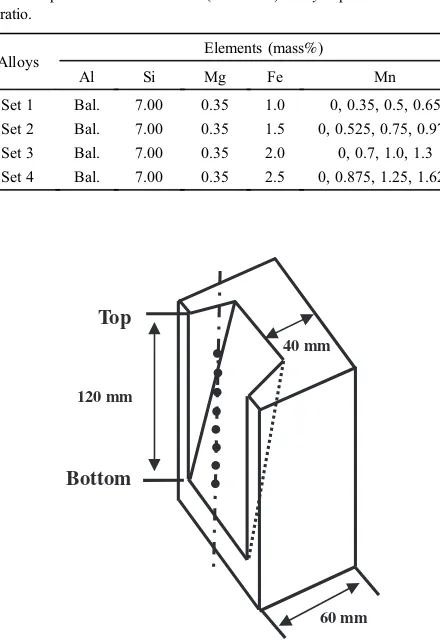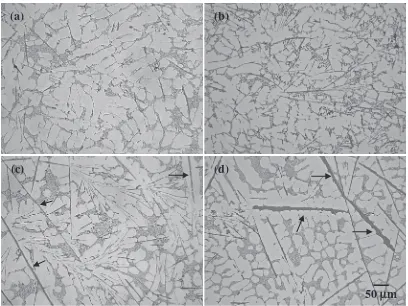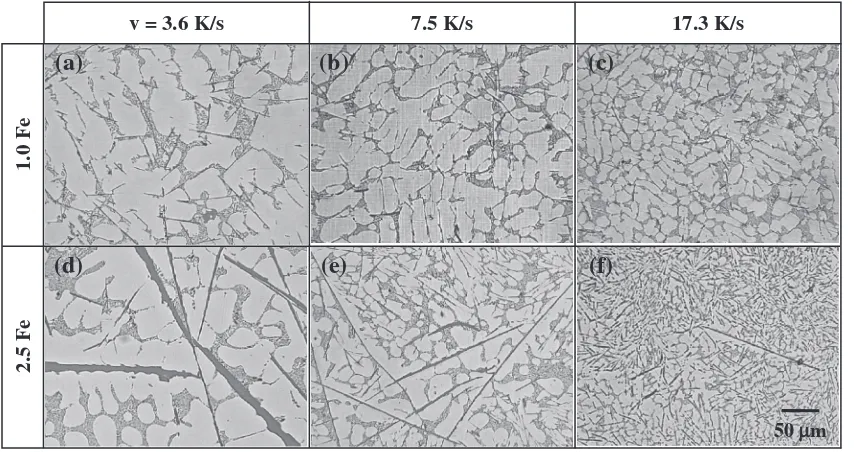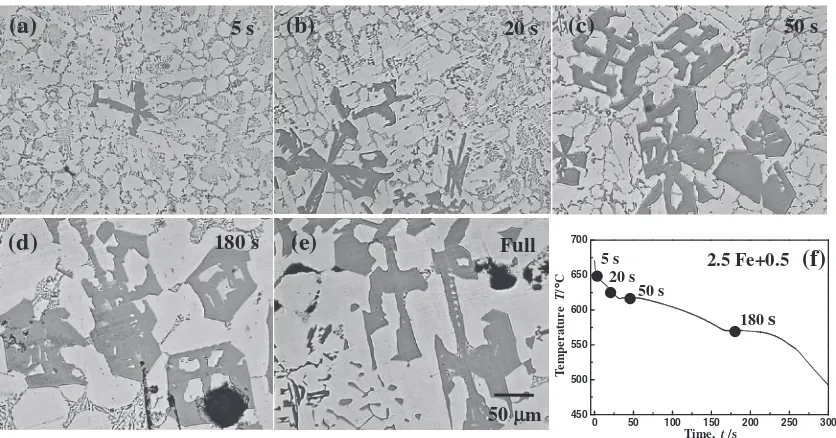Effects of the Mn
/
Fe Ratio and Cooling Rate on the Modi
fi
cation
of Fe Intermetallic Compounds in Cast A356 Based Alloy
with Different Fe Contents
Zhijun Zhang
1,+1, Hiroyasu Tezuka
1, Equo Kobayashi
1,+2and Tatsuo Sato
21Department of Metallurgy and Ceramics Science, Tokyo Institute of Technology, Tokyo 152-8552, Japan 2Precision and Intelligence Laboratory, Tokyo Institute of Technology, Yokohama 226-8503, Japan
In cast AlSi alloys, the platelet¢type Fe intermetallic compound has been considered as most detrimental Fe compounds to their mechanical properties, especially ductility. When the Fe is inevitable, to enhance the properties of the cast aluminum alloys, the modification of Fe compounds from the platelet¢type Fe compound to a more compact and less harmful¡type Fe compound having the Chinese script morphology becomes the efficient and important way. This work mainly investigated how did three factors, Fe content, Mn/Fe ratio and cooling rate combined influence this modification process in cast A356 (JIS, AC4C) based alloys. The results revealed that with increasing the Fe content in the alloy without Mn addition, the size of the platelet¢type Fe compound increases significantly under the same cooling rate. The Mn addition was effective to modify the platelet¢type Fe compound to more compact Chinese script and/or polyhedral shape¡type Fe compound. The ratio of these two kinds of¡type Fe compounds mainly depends on the Mn/Fe ratio and the cooling rate in a given Fe level. The further research work about the solidification sequence of Fe compounds during casting revealed that in the alloys without Mn addition, the Fe compounds only appeared as a platelet shape. With Mn addition, the Fe compound crystallized as the platelet¢type compound at the beginning of the solidification. With the solidification proceeding, the Chinese script¡type Fe compound became the dominant one. The formation of the polyhedral shape¡type Fe compound mainly came from the growth of the Chinese script¡type Fe compound. The ratio of these three Fe compounds was greatly influenced by the Mn/Fe ratio and cooling rate in a given Fe content. [doi:10.2320/matertrans.F-M2013808]
(Received November 20, 2012; Accepted May 8, 2013; Published June 21, 2013)
Keywords: cast aluminum alloys, iron intermetallic compounds, modification, solidification sequence
1. Introduction
Fe is always present in aluminum as a dominant impurity. Iron comes into aluminum from ores, anodic mass, master alloys, as well as from the steel equipment used in melting
and casting.1) Especially in the recycled alloys, the Fe
concentration usually is very high. In cast AlSi alloys, it is widely accepted that Fe is the most detrimental impurity. Three main kinds of brittle Fe intermetallic compounds can be formed by reacting of Fe with Al and Si during
solidification process due to its small solid solubility in the
Al matrix.2)The Fe intermetallic compounds are assumed to
act as stress raisers and are points of weak bond, causing reduction in mechanical properties, particularly the ductility of cast alloys. The deterioration of mechanical properties depends on the amount, size and type of Fe compounds. Among the three main Fe-rich compounds in cast AlSi
alloys, ¢ type Fe compound which usually appears as the
platelet shape (needle-like in the 2-D cross-section image),
has been identified as the most detrimental one in AlSi
alloy castings.35) The solubility of Mn in the ¢ type Fe
compound is very small. In the presence of more Mn addition, the chemical formula for another common Fe compound formed can be represented approximately by
Al15(Fe,Mn)3Si2, known as ¡ type Fe compound having an
appearance of the Chinese script morphology in section.6,7)
If Fe and Mn are sufficiently high, the third kind of Fe
compound, which has the similar composition and crystal
structure as that of the Chinese script ¡type Fe compound,
also confusingly known as the ¡ type Fe compound but
with the polyhedral shape.8,9) This compound has been
thought not to embrittle the alloy, but reduce the
machinability and its formation should be avoided.6)Efforts
are made to keep the Fe contents in Al alloys as low as possible. The strict requirement for low levels of Fe in the
cast aluminum alloys significantly increases costs. Hence,
how to improve the mechanical properties of cast aluminum alloys with high Fe content becomes important and necessary. When the Fe compounds are inevitable, the
Chinese script ¡ type Fe compound or the small size Fe
compounds are preferable.10)
Mn was usually added into the alloy to modify the platelet
¢ type Fe compound to the Chinese script ¡ type Fe
compound.11)Although the addition of Mn to AlSi alloys
has been widely investigated and documented, the amount of Mn needed to neutralize Fe has not been well established,
especially with the change in the cooling rate.12,13) The
previous works mainly revealed the influences of the
Mn and Fe content on the type and size of different Fe
compounds1416) or the cooling rate on the evolution of
different Fe compounds during the modification process17,18)
separately. Still very limited work has reported systematically
about the influences of the Fe content, the Fe/Mn ratio and
cooling rate on the modification of Fe compounds. This work
mainly investigate the combined influences of the Mn/Fe
ratio and cooling rate on the modification of Fe compounds
in cast A356 (JIS, AC4C) based alloys with different Fe
contents. Moreover, in order to control this modification
process well, to know the detailed solidification sequence
of the different Fe compounds are essential. In this work, the water-quenched experiments were conducted to reveal
the solidification sequence of the different Fe intermetallic
compounds.
+1Graduate Student, Tokyo Institute of Technology
2. Experimental Procedure
The alloys were molten in a graphite crucible under an Ar protective atmosphere by an electrical resistance furnace. The nominal compositions of the experimental A356 based alloys are given in Table 1. The Fe contents in each alloy
are 1.0, 1.5, 2.0 and 2.5 mass%, respectively. Different Mn
contents were added to make sure the Mn/Fe ratio are 0,
0.35, 0.5 and 0.65, respectively. The samples are named asx
Fe or x Fe+y in the text, where the x represents the Fe
content (in mass%) and yrepresents the Mn/Fe ratio. Each
alloy was cast into a stainless steel mold, as shown in Fig. 1. The thickness of the mold walls was designed getting thinner gradually from the bottom (60 mm) to the top (40 mm) to get the wedge shape cast. Hence, the different heights of the cast show the different cooling rates. During casting, the thermocouples were set in the center of the mold at different heights (20, 30, 40, 50, 60, 70, 80 and 90 mm from the bottom of the mold), to monitor the cooling curves. The calculated cooling rates based on the cooling curves were showed in Fig. 2. The casting temperature of 993 K was used throughout this study.
To investigate the solidification sequence of the different
Fe compounds, the water-quenched experiments during air
cooling were performed. The stainless steel cups coated with a thin layer of boron nitride were used, as shown in Fig. 3.
The cup was filled by dipping into the melt, temporarily
immersing it to attain thermal equilibrium with the melt. The mold with its liquid metal was then removed from the
melt and solidified in air. The K-type thermocouples were
located in the central areas of the cups to monitor the cooling curves during air cooling just after taking out the cups from the molten alloys. The cooling rate of this cup mold during
air cooling is 0.59 K/s. The onset of the air cooling was
counted from the time taking out the cups from the melt. For each alloy composition, four interrupted water-quenched experiments were carried out at 5, 20, 50 and 180 s timing from the start of the air cooling. The air cooling time which was used in the following description represents the period between onset of the air cooling and the water-quenched time.
The modification of Fe compounds was mainly revealed
by the morphology change of the shape and size of the different Fe compounds. Optical microscope was used to characterize the microstructure. Samples for the micro-structural analysis were prepared by standard techniques
with the final polishing stage using the 0.05 µm colloidal
[image:2.595.318.533.70.243.2]silica.
Table 1 Nominal compositions of the A356 based alloys with different Fe and Mn contents. The Mn/Fe ratios in each set are 0, 0.35, 0.5 and 0.65 respectively. The samples are named asxFe orxFe+yin the text, where thexrepresents the Fe content (in mass%) andyrepresents the Mn/Fe ratio.
Alloys Elements (mass%)
Al Si Mg Fe Mn
Set 1 Bal. 7.00 0.35 1.0 0, 0.35, 0.5, 0.65 Set 2 Bal. 7.00 0.35 1.5 0, 0.525, 0.75, 0.975 Set 3 Bal. 7.00 0.35 2.0 0, 0.7, 1.0, 1.3 Set 4 Bal. 7.00 0.35 2.5 0, 0.875, 1.25, 1.625
Bottom Top
60 mm 120 mm
40 mm
Fig. 1 Schematic drawing of a half of the symmetrical stainless steel casting mold for the wedge-shaped samples. The locations of the thermocouples during casting were marked by the close rounds. They are 20, 30, 40, 50, 60, 70, 80 and 90 mm from the bottom of the mold.
20 30 40 50 60 70 80 90
0 2 4 6 8 10 12 14 16 18 20
Different locations from the bottom of the mold, l / mm
Cooling rate,
v
/
K
·
s
-1
Fig. 2 Values of the cooling rates are averaged for the alloys with different Fe contents and no Mn addition.
[image:2.595.57.277.108.429.2] [image:2.595.92.249.229.426.2] [image:2.595.371.480.298.448.2]3. Results
3.1 Effect of the Fe content
Microstructures of the alloys with different Fe contents at
the low cooling rate (3.6 K/s, 90 mm) were showed in Fig. 4.
The size of the platelet ¢ type Fe compound particles
significantly increases with increasing the Fe content. The
larger size platelet ¢type Fe compound particles marked by
the arrows in Figs. 4(c) and 4(d) demonstrated that with
increasing the Fe content, the ¢type Fe compound
crystal-lized at higher temperature. Longer growth time will make
the size of the ¢type compound much larger.
3.2 Effect of the Mn/Fe ratio
The addition of Mn modified the platelet ¢ type Fe
compound to ¡ type Fe compound which appeared as both
Chinese script and polyhedral shape, as shown in Fig. 5. In
the alloy with both low Fe content and low Mn/Fe ratio, the
alloy 1.0 Fe+0.35, almost all of the Fe compound particles
showed the platelet shape, as shown in Fig. 5(a). With
increasing the Mn/Fe ratio, some of the platelet shape¢type
Fe compound particles were modified to the Chinese script¡
type Fe compound particles, marked by arrows in Fig. 5(b).
When the Mn/Fe ratio reached up to 0.65, most of the
platelet ¢ type Fe compound particles were modified.
However, still some platelet ¢ type Fe compound particles
existed, as shown in Fig. 5(c) marked by arrows.
By increasing the Fe content from 1.0 to 2.0 mass% with
the Mn/Fe ratio of 0.35, some of the platelet ¢ type Fe
compound particles were modified to both the Chinese script
and polyhedral shape ¡ type Fe compound particles, as
shown in Fig. 5(d). With increasing the Mn/Fe ratio to 0.5,
almost all the platelet ¢ type Fe compound particles were
replaced by ¡ type Fe compound particles. The ratio of the
polyhedral shape ¡ type Fe compound particles greatly
increased, as shown in Fig. 5(e). When the Mn/Fe ratio was
increased to 0.65, most of the Fe compounds became as the polyhedral shape, as shown in Fig. 5(f ).
When the Fe content was 2.5 mass%, the modification
of the Fe compounds by Mn addition showed the similar
phenomenon as that of the alloys with 2.0 mass% Fe and
different Mn/Fe ratio, as shown in Figs. 5(g)5(i). The
difference is that at the same Mn/Fe ratio, the volume
fraction of the polyhedral shape ¡ type Fe compound
particles increased, as shown in Figs. 5(f ) and 5(i).
3.3 Effect of the cooling rate
Figure 6 shows the microstructures of the alloys 1.0 Fe and 2.5 Fe at different cooling rates. In the alloy without the Mn addition, all the Fe compounds appeared in the form of platelet shape, as shown in Fig. 6. Changing the cooling rate can not modify the Fe compound in the type. However, the size of the Fe compounds can be altered. With increasing the
cooling rate from 3.6 K/s (90 mm) to 17.3 K/s (20 mm), the
size of the¢type Fe compound particles was refined from the
large one to the small one, regardless of the Fe content.
In the alloy 1.0 Fe+0.65 at the low cooling rate (3.6 K/s,
90 mm), most of the Fe compounds showed the Chinese script morphology, as shown in Fig. 7(a). With increasing the cooling rate, Fe compounds tended to appear in the form of
(a)
(b)
(c)
(d)
50
µ
m
[image:3.595.94.502.68.374.2]the platelet shape, as shown in Fig. 7(b). At high cooling rate
(17.3 K/s, 20 mm), most of the Fe compounds appeared in
the form of the small platelet shape, as shown in Fig. 7(c). In
the alloy 2.5 Fe+0.65 at low cooling rate (3.6 K/s, 90 mm),
most of the Fe compounds appeared in the form of the polyhedral shape, as shown in Fig. 7(d). With increasing the cooling rate, the size of Fe compounds decreased. Also, the
Chinese script¡type Fe compound is preferentially formed,
(d)
(e)
(f)
(g)
(h)
(i)
Mn / Fe = 0.35 0.5 0.65
(a)
(b)
(c)
1.0 F
e
2.5 F
e
2.0 F
e
50 µm
Fig. 5 Microstructures of the alloys with different Fe contents and Mn/Fe ratios at the height of 90 mm from the bottom of the mold: (a) 1.0 Fe+0.35 (b) 1.0 Fe+0.5 (c) 1.0 Fe+0.65 (d) 2.0 Fe+0.35 (e) 2.0 Fe+0.5 (f ) 2.0 Fe+0.65 (g) 2.5 Fe+0.35 (h) 2.5 Fe+0.5 (i) 2.5 Fe+0.65.
v = 3.6 K/s 7.5 K/s 17.3 K/s
50 µm
(a)
(b)
(c)
(d)
(e)
(f)
2.5 F
e
1.0 F
e
[image:4.595.87.511.70.399.2] [image:4.595.87.514.463.689.2]comparing with the formation of polyhedral shape Fe compound, as shown in Fig. 7(e). At the high cooling rate
(17.3 K/s, 20 mm), most of the Fe compounds appeared in
the shape of Chinese script, as shown in Fig. 7(f ). It is found that the high cooling rate suppresses the formation of the polyhedral shape Fe compounds comparing to the Chinese script.
It is indicted that the high cooling rate favored the
formation of the platelet ¢ type Fe compound. The high
cooling rate, however, restricted the formation of the polyhedral shape Fe compound in the alloy with the high
Fe content and Mn/Fe ratio.
4. Discussions
The platelet ¢ type Fe compound is known as very
detrimental to the mechanical properties of the cast AlSi alloys, especially ductility. The high Fe content tends to cause
the larger size platelet ¢ type Fe compound rather than
increasing its number density, as shown in Fig. 4. This larger
size platelet ¢ type Fe compound, which is believed to be
more detrimental, is considered to be formed earlier and hence more unconstrained growth occurs. The Fe content is
the main factor that influences the morphology of the Fe
compounds in cast AlSi alloys. Increasing the cooling rate can restrict the growth of the larger size Fe compounds and
other phases, which can be beneficial to the mechanical
properties of the cast Al alloys.
The addition of Mn results in the modification of the
morphology and type of intermetallic compounds from the
platelet ¢ type Fe compound to the Chinese script and/or
polyhedral shape ¡ type Fe compounds. Couture revealed
that if the iron content exceeded 0.45 mass%, the Mn content
should not be less than the half of the Fe content to modify all
of the platelet ¢ type Fe compounds.13) However, in this
work, this ratio was greatly affected by both the Fe content and cooling rate.
At the low Fe content, the high Mn/Fe ratio and low
cooling rate favor the formation of the Chinese script¡type
Fe compound, as shown in Fig. 7(a). Decreasing the Mn/Fe
ratio and increasing the cooling rate result in the increase in
the ratio of the platelet ¢ type Fe compound among the Fe
compounds, as shown in Figs. 5(a)5(c) and Figs. 7(b), 7(c).
On the other hand, at the high Fe content, the high Mn/Fe
ratio and low cooling rate favor the formation of the
polyhedral shape¡type Fe compound, as shown in Fig. 7(d).
Decreasing the Mn/Fe ratio and increasing the cooling rate
result in the decreased ratio of the polyhedral shape¡ type
Fe compound and the increased ratio of the Chinese script
¡ type Fe compound, as shown in Figs. 5(d)5(i) and
Figs. 7(e) and 7(f ).
Therefore, in order to modify the platelet ¢ type Fe
compound to the Chinese script ¡ type Fe compound and
to avoid the formation of the polyhedral shape ¡ type Fe
compound, the critical Mn/Fe ratio and cooling rate should
be mainly considered at a given Fe content. In the alloy with
1.0 mass%Fe, the Mn/Fe ratio should be larger than 0.65 to
modify the remained platelet ¢ type Fe compound at the
cooling rate of 3.6 K/s (90 mm), as shown in Fig. 7(a). If
increasing the cooling rate under the same situation, this
Mn/Fe ratio should be much larger, as shown in Figs. 7(b)
and 7(c). In the alloys with 2.0 mass%Fe and 2.5 mass%Fe,
the Mn/Fe ratio should be between 0.35 and 0.5 to modify
the remained platelet¢ type Fe compound and decrease the
ratio of the polyhedral shape ¡ type Fe compound at low
cooling rate (3.6 K/s, 90 mm), as shown in Figs. 5(d), 5(e),
5(g) and 5(i). Increasing the cooling rate to a high level
(17.3 K/s, 20 mm), the Mn/Fe ratio also should be less than
0.65 to decrease the ratio of the polyhedral shape¡type Fe
compound as much as possible, as shown in Fig. 7(f ). Additionally, most of the Fe compounds appeared as the
platelet shape at the low Fe content with high Mn/Fe ratio
and as the Chinese script shape at high Fe content with high
Mn/Fe under the high cooling rate, as shown in Figs. 7(c)
50 µµm
(a)
(b)
(c)
(d)
(e)
(f)
v = 3.6 K/s 7.5 K/s 17.3 K/s
2.5 F
e + 0.65
1.0 F
e + 0.65
[image:5.595.88.507.69.295.2]and 7(f ). It is considered that the platelet ¢ type Fe
compound can solidify earlier than Chinese script ¡ type
Fe compound. The formation of the polyhedral shape Fe compound mainly came from the growth of the Chinese script Fe compound.
For the further understanding of the solidification sequence
of the different Fe compounds, the water-quenched experi-ments during air cooling were conducted. The results are
shown in Figs. 8 and 9. In the alloy 1.0 Fe+0.5, the Fe
compounds appeared as the very small size platelet shape at
the beginning of the solidification, as shown in Fig. 8(a).
With increasing the air cooling time, the size of these small Fe compounds increased along with the decrease of their number density, as shown in Figs. 8(b) and 8(c). Almost no compound appeared as Chinese script shape even the air
cooling time was 50 s. However, when the air cooling time reached to 180 s, most of the Fe compounds showed the Chinese script. Meanwhile, the amount and volume fraction of platelet Fe compound decreased, as shown in Figs. 8(c) and 8(d). This is the direct evidence to prove that the Fe
compound crystallized as the platelet ¢ type compound at
the beginning of the solidification. With the solidification
proceeding, the Chinese script¡type Fe compound became
the dominant one.
In the alloy 2.5 Fe+0.5, even at the beginning of the
solidification, most of the Fe compounds appeared as the
Chinese script shape and some of them appeared as the polyhedral shape, as shown in Fig. 9(a). With increasing the air cooling time, the size and ratio of the polyhedral shape Fe compound particles greatly increased along with the decrease
0 50 100 150 200 250 300
450 500 550 600 650 700
Time, t /s
1.0 Fe+0.5 5 s
20 s 50 s
180 s
(f)
(a)
5 s(b)
20 s(c)
50 s(d)
180 s(e)
Full50 µm
T
emperatur
e
,
T
/
°
C
Fig. 8 Microstructures of the alloy 1.0 Fe+0.5 water-quenched after different air cooling time: (a) 5 s, (b) 20 s, (c) 50 s, (d) 180 s and (e) full solidification and its full cooling curve (f ).
(a)
5 s(b)
20 s(c)
50 s(d)
180 s(e)
Full50 µµm
(f)
0 50 100 150 200 250 300
450 500 550 600 650 700
2.5 Fe+0.5 5 s
20 s 50 s
180 s
Time, t /s
T
emperatur
e
T
/
°
C
[image:6.595.90.509.68.287.2] [image:6.595.89.507.339.558.2]of the ratio of the Chinese script Fe compound particles, as shown in Fig. 9(b). Most of the Fe compounds appeared as the polyhedral shape at the air cooling time of 50 s, 180 s and
full solidification, as shown in Figs. 9(c)9(e). It is clearly
demonstrated that most of the polyhedral shape Fe compound particles came from the growth of the Chinese script Fe
compound particles, not solidified as the primary phase.
5. Conclusions
The influence of the Fe content, Mn/Fe ratio and cooling
rate on the modification process of the Fe intermetallic
compounds in the cast A356 based alloys was investigated.
Moreover, the solidification sequence of the Fe compounds
was revealed by water-quenched experiments. The obtained results are summarized as follows:
(1) Fe content greatly influences the size of the platelet ¢
type Fe compound in the alloys without Mn addition.
The size of the ¢ type Fe compound increases
significantly with increasing the Fe content.
(2) The Mn addition was effective to modify the platelet
¢ type Fe compound to more compact compounds,
Chinese script and/or polyhedral shape ¡ type Fe
compound. The ratio of these different Fe compounds
was greatly affected by the Mn/Fe ratio and the cooling
rate in a given Fe level.
(3) In the alloys with Mn addition, the Fe compound
crystallized as the platelet ¢type Fe compound at the
beginning of the solidification. With the solidification
proceeding, the Chinese script ¡ type Fe compound
became the dominant one. Additionally, the formation
of polyhedral shape¡type Fe compound mainly came
from the growth of Chinese script¡type Fe compound.
Acknowledgments
The authors acknowledge the financial support from the
Japan Foundry Engineering Society and the China
Scholar-ship Council (CSC) for the award of a scholarScholar-ship to thefirst
author for his study in Japan as a doctoral student.
REFERENCES
1) N. A. Below, A. A. Aksenov and D. G. Eskin:Iron in Aluminum Alloys, (Taylor & Francis Inc, New York, 2002) pp. 17.
2) L. Wang, D. Apelian and M. M. Makhlouf: AFS Trans.146(1999) 231238.
3) L. Backerud, G. Chai and J. Tamminen:Solidification Characteristics of Aluminium Alloys, Foundry Alloys Vol. 2, (AFS/Skanaluminum, 1990) pp. 7184.
4) S. Shivkumar, L. Wang and D. Apelian:JOM43(1991) 2632.
5) P. Ashtari, H. Tezuka and T. Sato:Scr. Mater.51(2004) 4346.
6) L. F. Mondolfo: Aluminum Alloys: Structure and Properties, (Butterworths, London, 1976) 661663.
7) M. V. Kral:Mater. Lett.59(2005) 22712276.
8) X. J. Cao and J. Campbell: Int. J. Cast Met. Res.13(2000) 175184. 9) X. J. Cao and J. Campbell: Shape Casting: The John Campbell Symposium, ed. by M. Tiryakiogly and P. N. Crepeau, (The Minerals, Metals & Materials Society, 2005) pp. 255262.
10) S. Seifeddine and I. L. Svensson: Metall. Sci. Technol.27(2009) 11 20.
11) P. Ashtari, H. Tezuka and T. Sato:Mater. Trans.44(2003) 26112616.
12) P. N. Crepeau: AFS Trans.103(1995) 361366. 13) A. Couture: AFS Int. Casting Metals J.6(1981) 917. 14) S. G. Shabestari: Mater. Sci. Eng. A383(2004) 289298.
15) J. Y. Hwang, H. W. Doty and M. J. Kaufman:Mater. Sci. Eng. A488
(2008) 496504.
16) C. M. Dinnis, J. A. Tayor and A. K. Dahle:Metall. Mater. Trans. A37
(2006) 32833291.
17) B. Dutta and M. Rettenmayr:Mater. Sci. Eng. A283(2000) 218224.




